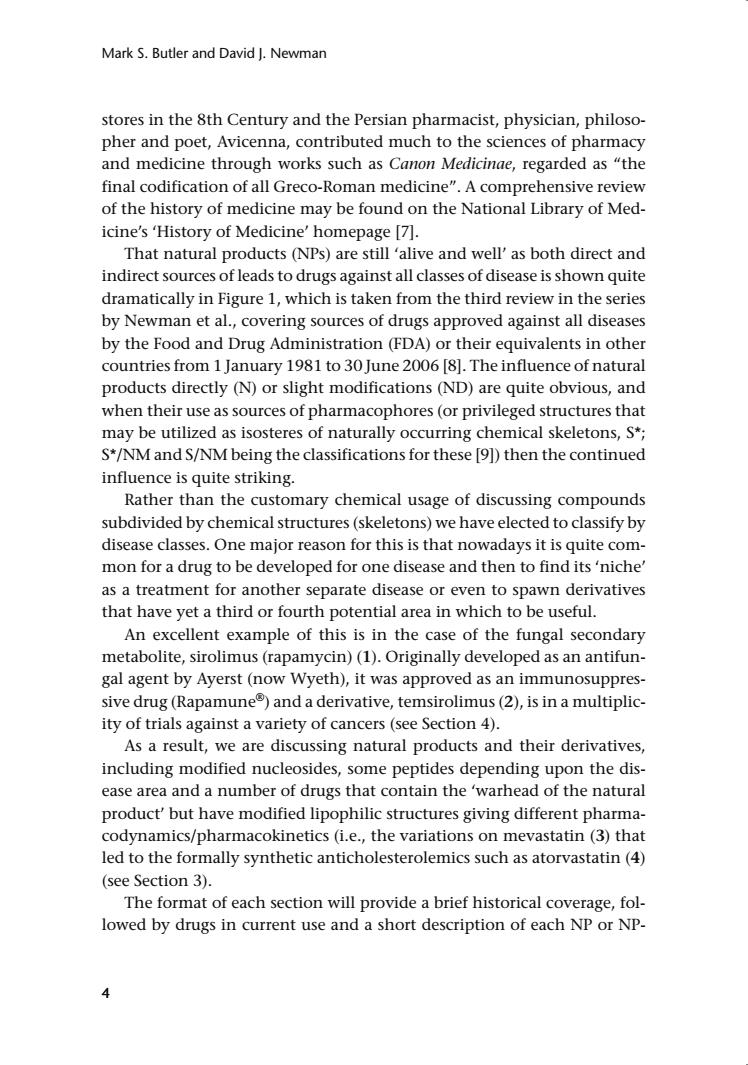正在加载图片...

Mark S.Butler and David J.Newman stores in the 8th Century and the Persian pharmacist,physician,philoso- pher and poet,Avicenna,contributed much to the sciences of pharmacy and medicine through works such as Canon Medicinae,regarded as "the final codification of all Greco-Roman medicine".A comprehensive review of the history of medicine may be found on the National Library of Med- cine's History of Medicine'homepage [7] That natural products(NPs)are still 'alive and well'as both direct and indirect sources of leads to drugs against all classes of disease is shown quite dramatically in Figure 1,which is taken from the third review in the series by Newman et al.,covering sources of drugs approved against all diseases by the Food and Drug Administration (FDA)or their equivalents in other countries from 1January 1981 to 30 June 2006 [8].The influence of natural products directly (N)or slight modifications (ND)are quite obvious,and when their use as sources of pharmacophores(or privileged structures that may be utilized as isosteres of naturally occurring chemical skeletons,S" S*/NM and S/NM being the classifications for these [9])then the continued nfluence is quite striking. Rather than the customary chemical usage of discussing compounds subdivided by chemical structures(skeletons)we have elected to classify by disease classes.One major reason for this is that nowadays it is quite com- mon for a drug to be developed for one disease and then to find its'niche' as a treatment for another separate disease or even to spawn derivatives that have yet a third or fourth potential area in which to be useful. An excellent example of this is in the case of the fungal secondary metabolite,sirolimus(rapamycin)(1).Originally developed as an antifun- gal agent by Ayerst(now Wyeth),it was approved as an immunosuppres- sive drug(Rapamune)and a derivative,temsirolimus(2),is in a multiplic- ity of trials against a variety of cancers(see Section 4). As a result,we are discussing natural products and their derivatives, including modified nucleosides,some peptides depending upon the dis ease area and a number of drugs that contain the 'warhead of the natural product'but have modified lipophilic structures giving different pharma codynamics/pharmacokinetics(i.e.,the variations on mevastatin(3)that led to the formally synthetic anticholesterolemics such as atorvastatin(4) (see Section 3). The format of each section will provide a brief historical coverage,fol- lowed by drugs in current use and a short description of each NP or NP. 4 Mark S. Butler and David J. Newman 4 stores in the 8th Century and the Persian pharmacist, physician, philosopher and poet, Avicenna, contributed much to the sciences of pharmacy and medicine through works such as Canon Medicinae, regarded as “the final codification of all Greco-Roman medicine”. A comprehensive review of the history of medicine may be found on the National Library of Medicine’s ‘History of Medicine’ homepage [7]. That natural products (NPs) are still ‘alive and well’ as both direct and indirect sources of leads to drugs against all classes of disease is shown quite dramatically in Figure 1, which is taken from the third review in the series by Newman et al., covering sources of drugs approved against all diseases by the Food and Drug Administration (FDA) or their equivalents in other countries from 1 January 1981 to 30 June 2006 [8]. The influence of natural products directly (N) or slight modifications (ND) are quite obvious, and when their use as sources of pharmacophores (or privileged structures that may be utilized as isosteres of naturally occurring chemical skeletons, S*; S*/NM and S/NM being the classifications for these [9]) then the continued influence is quite striking. Rather than the customary chemical usage of discussing compounds subdivided by chemical structures (skeletons) we have elected to classify by disease classes. One major reason for this is that nowadays it is quite common for a drug to be developed for one disease and then to find its ‘niche’ as a treatment for another separate disease or even to spawn derivatives that have yet a third or fourth potential area in which to be useful. An excellent example of this is in the case of the fungal secondary metabolite, sirolimus (rapamycin) (1). Originally developed as an antifungal agent by Ayerst (now Wyeth), it was approved as an immunosuppressive drug (Rapamune®) and a derivative, temsirolimus (2), is in a multiplicity of trials against a variety of cancers (see Section 4). As a result, we are discussing natural products and their derivatives, including modified nucleosides, some peptides depending upon the disease area and a number of drugs that contain the ‘warhead of the natural product’ but have modified lipophilic structures giving different pharmacodynamics/pharmacokinetics (i.e., the variations on mevastatin (3) that led to the formally synthetic anticholesterolemics such as atorvastatin (4) (see Section 3). The format of each section will provide a brief historical coverage, followed by drugs in current use and a short description of each NP or NP- 4